NVIDIA GeForce GTX 670 Review Feat. EVGA: Bringing GK104 Down To $400
by Ryan Smith on May 10, 2012 9:00 AM ESTOC: Power, Temperature, & Noise
Our final task is our look at GTX 670’s overclocking capabilities. Based on what we’ve seen thus far with GTX 670, it looks like NVIDIA is binning chips based on functional units rather than clockspeeds. As a result GTX 670 could have quite a bit of overclocking potential, albeit one still limited by the lack of voltage control.
| GeForce 600 Series Overclocking | |||||
| GTX 670 | EVGA GTX 670SC | GTX 680 | |||
| Shipping Core Clock | 915MHz | 967MHz | 1006MHz | ||
| Shipping Max Boost Clock | 1084MHz | 1188MHz | 1110MHz | ||
| Shipping Memory Clock | 6GHz | 6GHz | 6GHz | ||
| Shipping Max Boost Voltage | 1.175v | 1.162v | 1.175v | ||
| Overclock Core Clock | 1065MHz | 1042MHz | 1106MHz | ||
| Overclock Max Boost Clock | 1234MHz | 1263MHz | 1210MHz | ||
| Overclock Memory Clock | 6.9GHz | 6.6GHz | 6.5GHz | ||
| Overclock Max Boost Voltage | 1.175v | 1.162v | 1.175v | ||
Because of the wider gap between base clock and boost clock on the GTX 670 we see that it doesn’t overclock quite as far as GTX 680 from a base clock perspective, but from the perspective of the maximum boost clock we’ve slightly exceeded the GTX 680. Depending on where a game lands against NVIDIA’s power targets this can either mean that an overclocked GTX 670 is faster or slower than an overclocked GTX 680, but at the same time it means that overclocking potential is clearly there.
We’re also seeing another strong memory overclock out of a GK104 card here. GTX 680 only hit 6.5GHz while GTX 690 could hit 7GHz. GTX 670 is only a bit weaker at 6.9GHz, indicating that even with the relatively small PCB that NVIDIA can still exceed the high memory clocks they were shooting for. At the same time however this is a luck of the draw matter.
The EVGA card meanwhile fares both worse and better. Its gap between the base clock and and maximum boost clock is even larger than the reference GTX 670, leading to it having an even lower overclocked base clock but a higher overclocked maximum boost clock. The real limiting factor however is that it couldn’t reach a memory overclock quite as high as the reference GTX 670 – again, luck of the draw – which means it can’t match the overclocked reference GTX 670 as it’s going to be more memory bandwidth starved more often.
Moving on to our performance charts, we’re going to once again start with power, temperature, and noise, before moving on to gaming performance. We’ll be testing our GTX 670 cards at both stock clocks with the maximum power target of 122% (170W) to showcase what is possible at validated clockspeeds with a higher power cap, and a true overclock with a maximum power target along with the largest clock offsets we can achieve.
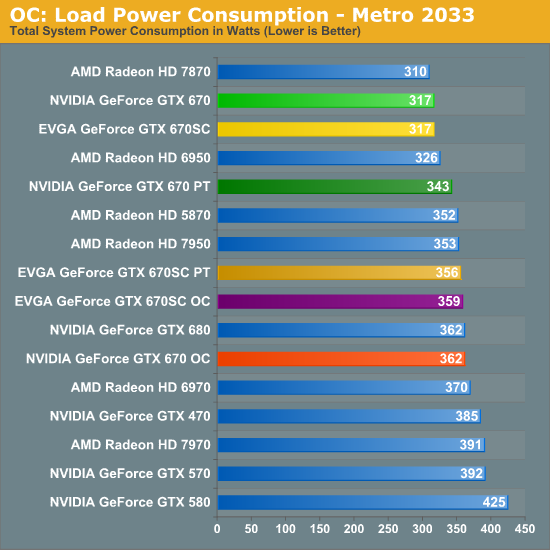
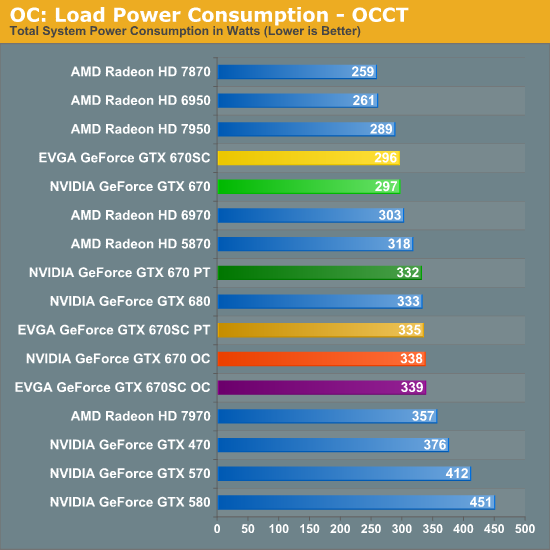
Not surprisingly, since we’re almost always operating within the realm of the power target as opposed to the TDP on the GTX 600 series, our power consumption closely follows our chosen power target. Cranking up the power target on the GTX 670 for example to 170W puts us within 6W of the GTX 680, which itself had a 170W power target in the first place. This is true for both Metro and OCCT, which means power consumption is very predictable when doing any kind of overclocking.
This also means that power consumption is still 18W-30W below the 7970, which in turn means that if these overclocks can close the performance gap, then the GTX 670 still has a power consumption advantage.
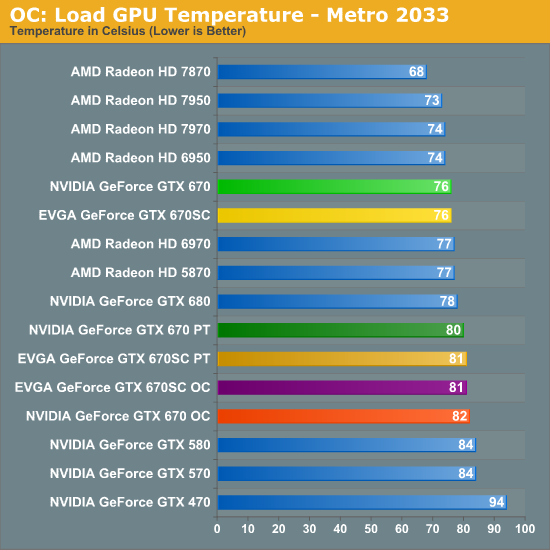
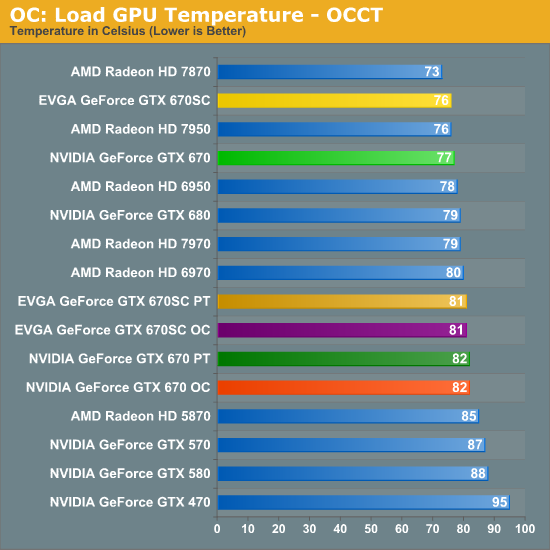
As to be expected, with an increase in power consumption comes an increase in load temperatures. However the fact that we’re only able to increase power consumption by about 30W means the temperature rise is limited to 4-5C, pushing temperatures into the low 80s. This does end up being warmer than the equivalent GTX 680 however due to the 680’s superior heatsink.
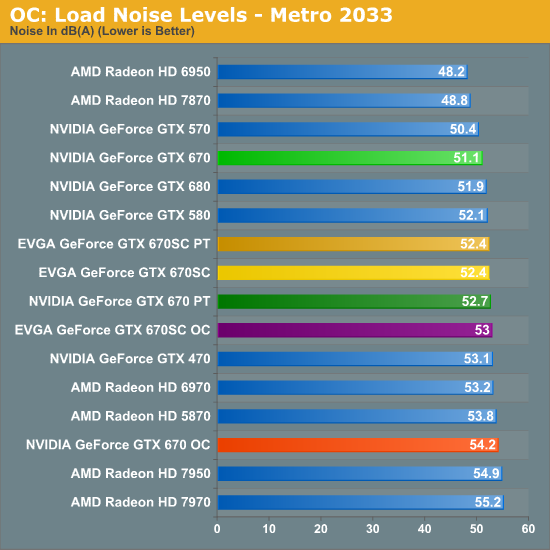

Finally, when it comes to noise we’re also seeing the expected increase, but again it’s rather small. Under Metro the amount of noise from the reference GTX 670 rises by under 3dB when pushing the power target higher on its own, while it rises 3dB when adding in our full overclock. Again the smaller cooler means that the GTX 670’s fan has to work harder here, which means our gaming performance may be able to reach the GTX 680, but our noise is going to slightly exceed it. As a point of reference, in the process we’ll also exceed the GTX 580’s noise levels under Metro. Still, in both OCCT and Metro none of our GTX 670 cards exceed the Radeon HD 7900 series, which means we've managed to increase our performance relative to those cards without breaching the level of noise they generate in the first place.










414 Comments
View All Comments
CeriseCogburn - Friday, May 11, 2012 - link
Wasn't caught ? LOL Sounds correct, at least in your mind.Problem is when amd is caught red handed, none of you amd fanboys have a clue about it, ever.
Now I don't have anything against AMD, it's just clear the truth should be told, as I said let's apply the amd fanboy talking points equally, let's do a real analysis and not with instant amnesia that favors amd or ignores the current facts like egg sales.
I have noticed you amd fans have a real hatred for nVidia and all say a similar thing as you just did. It's like poor loser syndrome but I don't think any of you are faking it, I think you are living it in your minds.
That's really sad.
I do believe that's why you can so blindly deny facts and are so often excuse makers and liars for amd and against nVidia quite unfairly. Cut out the hate man. nVidia isn't somehow worse than amd, nor vise versa.
Now I assure you, my post you went into attack mode over above is very simply my on the fly instant analysis by assembling the known facts. It includes principles like what's good for the goose is also fair on the gander, and very simple logic, and some actual original thoughts, etc.
My apologies that I am so excessively astute and can easily see though the amd fud monkey tp, and worse yet, right, show easily the actual nVidia advantage in that very area.
I'm gifted.
SlyNine - Saturday, May 12, 2012 - link
The GTX680 has out sold the 78xx line, interesting, but you need to prove it.CeriseCogburn - Saturday, May 12, 2012 - link
Go to new egg and click on the best selling EVGA GTX680, go to the reviews tab, click the verified buys checkmark, and read the number of verified buyers of the total commenters.That gives you a fair estimate that will be about the same as fair estimates for other products ( it eliminates counting spammers who just have to post without purchasing ).
So just go do that also for the 7870 and 7850 and add up all the totals, and of course include on the 7870 and 7850 and out of stock cards, the "up to 5 eggs" reviews are available for out of stock...
Compare your totals, if you don't know how to navigate new egg efficiently the tip you need is use the "Guided Results" tab on the upper left area once you have clicked into "Desktop Graphics Hardware" from the "shop all stores" yellow upper left start button.
So anyway, 680 was 108 verified a few days ago and all the 7870 and 7850 combined in total were below that by like 30 something - only a single 680 sku was needed, making it easier to collate in the nVidia side.
It should take you all of 3 minutes to verify this right now, and given the level of competence in this post area, here's some helpful starts
http://www.newegg.com/Product/Product.aspx?Item=N8...
680 single sku up to 111 now up from 108
78xx series link access below
http://www.newegg.com/Product/ProductList.aspx?Sub...
There you are, the proof you demanded, once again delivered.
SlyNine - Saturday, May 12, 2012 - link
So that's you're premise for total sales, how many verified buyers there are on neweggs REVIEWS. That's one hella questionable premise and invalid inference of the data available.lmao. Epic fail. Take a logic class
CeriseCogburn - Sunday, May 13, 2012 - link
Yes whine about the data set all you want, but we also have reviewer commentary that is confirming in this, with zero counters by you and yours.Newegg is actually quite an accurate machine for such a thing, best price, best known, most used, and has shown accuracy for a long time in this manner.
Foreigners (non USA) may argue but we don't see any counter arguments now do we mr sad 5870 ? :)
MrSpadge - Thursday, May 10, 2012 - link
You should compare to HD7950 or HD7970 instead of HD6970.. otherwise it's a no brainer ;)chizow - Thursday, May 10, 2012 - link
Certainly a better effort from Nvidia but the premiums are still a product of AMD's overpriced 28nm parts.If AMD priced as they should've from the outset based on historical pricing and relative performance to 40nm parts, we would've seen:
7970 @ $380
7950 @ $300
and Nvidia's parts would've fallen into place accordingly as well:
680 @ $400-$420
670 @ $350
GK110/685 @ $500-$550
GTX 690 @ $700-800
I guess we can't fault Nvidia too much though. In the end they can't keep GK104 in stock anywhere and they still manage to beat AMD convincingly in both price and performance.
The consumer is the one that loses however, paying high premiums for the smallest increase in performance for a full generational/process node improvement.
XZerg - Thursday, May 10, 2012 - link
The price gauging is always a product when the underdog in a market (not necessarily in performance) outdoes the big boss. We saw this happen back when AMD brought out the A64 as well or when ATI released R300 chip. So from consumer's $$$ point of view underdog should stay underdog but deliver performance that matches the big boss.JlHADJOE - Thursday, May 10, 2012 - link
G92 baby!90% of 8800GTX performance at less than half the price.
It was so good, it actually stayed competitive through 3 or 4 product cycles (albeit getting a new sticker every time).
CeriseCogburn - Thursday, May 10, 2012 - link
That's a failed analysis since the price gouging by the same complainers is always present on the flagship models.The true analysis is the honest and common sense one. No matter what anyone's twisted brain calls the competers, when any one in competition throws up a leader board item, they charge for it.
What's shameful in amd's case is the very quick slap down they experienced - smacking $579.99 down to $449.99(or 479) then the second whallop sending them to the deck, the 3 games they offered to attempt to keep interest going, and now another knockout punch square to the drooling amd choppers as they wobbled on noodle legs still getting the former ten count - the GTX670 tag team card with the new smack down....
I suspect amd will try to maintain some sort of composure and self esteem this time by not budging as long as they possibly can... because it's embarrassing already and now the GTX670 has turned amd from bright pink to their standard red color - flush to the point of passing out.
Yes, amd will pretend now - pretend it doesn't have to drop prices again.